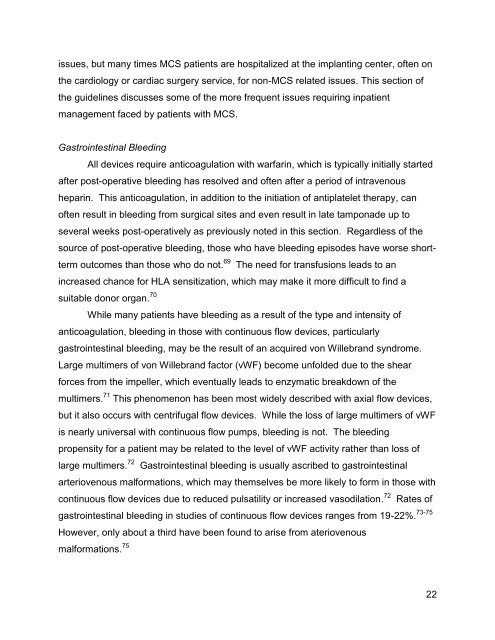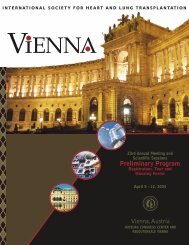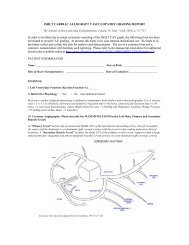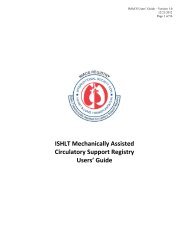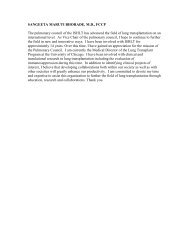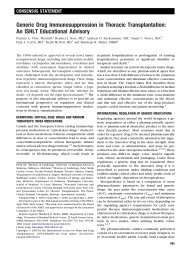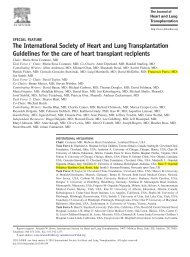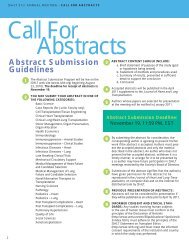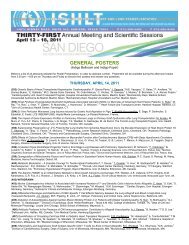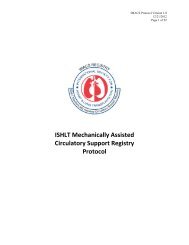Task Force 4: Inpatient Management of Patients with MCSD - The ...
Task Force 4: Inpatient Management of Patients with MCSD - The ...
Task Force 4: Inpatient Management of Patients with MCSD - The ...
Create successful ePaper yourself
Turn your PDF publications into a flip-book with our unique Google optimized e-Paper software.
issues, but many times MCS patients are hospitalized at the implanting center, <strong>of</strong>ten on<br />
the cardiology or cardiac surgery service, for non-MCS related issues. This section <strong>of</strong><br />
the guidelines discusses some <strong>of</strong> the more frequent issues requiring inpatient<br />
management faced by patients <strong>with</strong> MCS.<br />
Gastrointestinal Bleeding<br />
All devices require anticoagulation <strong>with</strong> warfarin, which is typically initially started<br />
after post-operative bleeding has resolved and <strong>of</strong>ten after a period <strong>of</strong> intravenous<br />
heparin. This anticoagulation, in addition to the initiation <strong>of</strong> antiplatelet therapy, can<br />
<strong>of</strong>ten result in bleeding from surgical sites and even result in late tamponade up to<br />
several weeks post-operatively as previously noted in this section. Regardless <strong>of</strong> the<br />
source <strong>of</strong> post-operative bleeding, those who have bleeding episodes have worse shortterm<br />
outcomes than those who do not. 69 <strong>The</strong> need for transfusions leads to an<br />
increased chance for HLA sensitization, which may make it more difficult to find a<br />
suitable donor organ. 70<br />
While many patients have bleeding as a result <strong>of</strong> the type and intensity <strong>of</strong><br />
anticoagulation, bleeding in those <strong>with</strong> continuous flow devices, particularly<br />
gastrointestinal bleeding, may be the result <strong>of</strong> an acquired von Willebrand syndrome.<br />
Large multimers <strong>of</strong> von Willebrand factor (vWF) become unfolded due to the shear<br />
forces from the impeller, which eventually leads to enzymatic breakdown <strong>of</strong> the<br />
multimers. 71 This phenomenon has been most widely described <strong>with</strong> axial flow devices,<br />
but it also occurs <strong>with</strong> centrifugal flow devices. While the loss <strong>of</strong> large multimers <strong>of</strong> vWF<br />
is nearly universal <strong>with</strong> continuous flow pumps, bleeding is not. <strong>The</strong> bleeding<br />
propensity for a patient may be related to the level <strong>of</strong> vWF activity rather than loss <strong>of</strong><br />
large multimers. 72 Gastrointestinal bleeding is usually ascribed to gastrointestinal<br />
arteriovenous malformations, which may themselves be more likely to form in those <strong>with</strong><br />
continuous flow devices due to reduced pulsatility or increased vasodilation. 72 Rates <strong>of</strong><br />
gastrointestinal bleeding in studies <strong>of</strong> continuous flow devices ranges from 19-22%. 73-75<br />
However, only about a third have been found to arise from ateriovenous<br />
malformations. 75<br />
22


